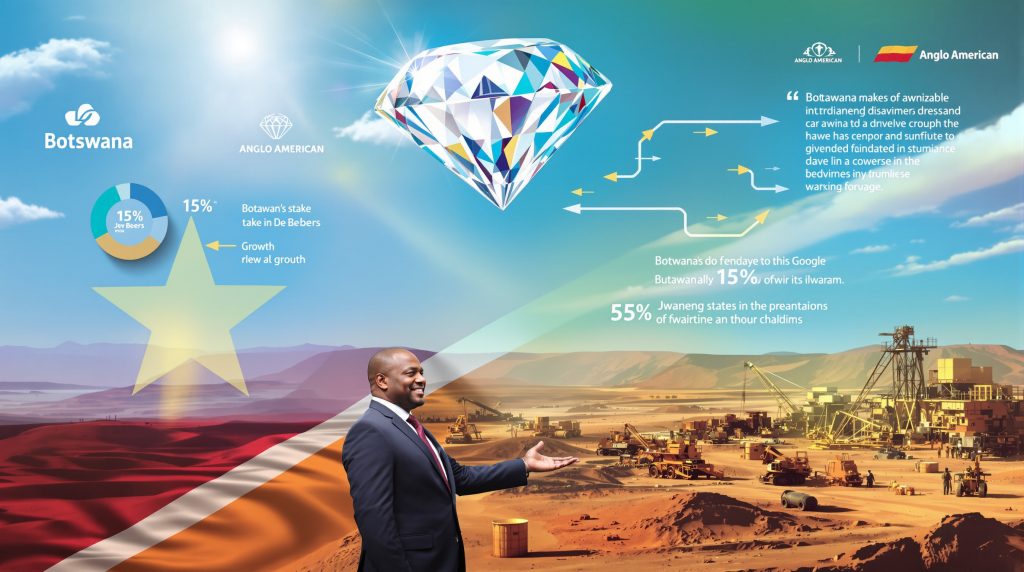The Strategic Dynamics of Anglo American's De Beers Sale: Botswana's Pivotal Role
Anglo American's divestiture of its 85% stake in De Beers represents a watershed moment in the global diamond industry. This high-stakes transaction carries profound implications for diamond market dynamics, African resource sovereignty, and the strategic trajectories of both companies. While Anglo American initially valued De Beers at approximately $5 billion, market analysts suggest a more realistic valuation between $2.5-4 billion, reflecting ongoing volatility in the diamond market.
The sale has attracted significant attention not only for its financial magnitude but for its unique negotiation structure, which positions Botswana as a central participant rather than a passive minority stakeholder.
What is at stake in the Anglo American-De Beers sale?
The De Beers divestiture represents one of the most significant ownership shifts in the diamond industry's recent history. With De Beers controlling a substantial portion of global diamond production and distribution, the transaction's outcome will reverberate throughout the diamond value chain, potentially reshaping industry evolution trends that have persisted for generations.
For Anglo American, this sale forms a critical component of their broader strategic restructuring, as the mining giant pivots toward core mining assets and responds to shareholder demands for portfolio optimization.
Current Market Challenges Driving the Sale
De Beers' financial performance has deteriorated significantly, posting a substantial $189 million loss for the first half of 2024. This financial downturn reflects broader challenges facing the natural diamond industry:
- Persistent market oversupply creating downward price pressure
- Reduced consumer demand in key markets including China and the United States
- Heightened competition from laboratory-grown diamonds capturing market share
- Financing challenges across the diamond supply chain
- Rising production costs at aging diamond operations
These market headwinds have contributed to Anglo American's decision to divest its De Beers stake, viewing the diamond business as increasingly peripheral to its core mining portfolio focused on copper, iron ore, and other industrial metals with stronger long-term demand fundamentals.
How is Botswana changing the dynamics of the sale process?
In a significant departure from conventional corporate divestiture practices, Anglo American CEO Duncan Wanblad has positioned Botswana's government as an active participant in finalizing any transaction. Rather than conducting a traditional multi-round bidding process with the highest bidder emerging victorious, Anglo is advancing to final negotiations with select shortlisted bidders while explicitly incorporating Botswana in the decision-making process.
Speaking at the Financial Times Metals and Mining Summit, Wanblad explained: "This isn't going to be the classical first round, second round sale process that you would ordinarily receive for businesses of this type. What we are planning to do is now move into the second round with one or two of the potential selected buyers that came through the first round with us and work with the Government of Botswana in finalising an agreement that works not only for the potential buyers, but also for Botswana."
Botswana's Unique Position of Influence
Botswana occupies an extraordinarily influential position in the De Beers sale process due to several factors:
- Current 15% ownership stake in De Beers, making it the only other shareholder besides Anglo American
- 50% ownership of Debswana, the joint venture that operates Botswana's world-class diamond mines
- Host country to Jwaneng mine, often called the "crown jewel" in De Beers' production portfolio
- Legal rights as a minority shareholder to influence certain corporate decisions
- Strategic importance as De Beers' largest source of high-quality diamonds
President Duma Boko has taken a notably assertive stance regarding De Beers, publicly criticizing Anglo American's management and explicitly stating his administration's ambition to gain controlling interest in the company. This political dimension adds significant complexity to what might otherwise be a straightforward corporate transaction.
Timeline and Process Structure
Anglo American has outlined a modified sale process with several distinct phases:
- Initial bidding round (completed)
- Selection of one or two preferred bidders for final negotiations
- Direct participation of Botswana government in these final-stage discussions
- Target of concluding negotiations within approximately six months from October 2024
- Potential spin-off option remains available if sale negotiations fail to yield satisfactory results
This unique structure acknowledges Botswana's extraordinary leverage in the transaction while still maintaining Anglo American's flexibility to pursue alternative options if necessary.
Why does Botswana want control of De Beers?
Botswana's aggressive pursuit of a controlling stake in De Beers represents a strategic national priority aimed at securing greater economic sovereignty and capturing more value from its natural resources. This ambition emerges from both economic necessity and a vision for the country's long-term development.
President Boko has stated his administration could manage De Beers more effectively than Anglo American, particularly given the challenging market conditions. This perspective reflects a growing confidence among resource-rich African nations in their capacity to control and maximize returns from their natural endowments.
Strategic National Interests
Botswana's diamond sector forms the backbone of its economy, with diamonds contributing significantly to GDP, employment, government revenue, and foreign exchange. Beyond these immediate economic interests, control of De Beers would provide Botswana with several strategic advantages:
- Enhanced influence over global diamond pricing and supply management
- Greater ability to direct exploration and production decisions
- Opportunity to develop downstream industries including cutting, polishing, and jewelry manufacturing
- Potential to capture additional value across the diamond supply chain
- Maximized returns from remaining diamond reserves as resource depletion approaches in coming decades
- Increased national prestige and negotiating leverage with international partners
- Platform for broader economic diversification initiatives leveraging diamond revenues
For Botswana, securing control of De Beers represents not merely an investment opportunity but a strategic imperative tied to the country's long-term economic sovereignty and development agenda, similar to other nations seeking mineral beneficiation insights to maximize economic returns from natural resources.
What complications have emerged in the bidding process?
The De Beers sale has attracted interest from multiple stakeholders, creating a complex negotiation landscape with competing national interests and strategic visions for the company's future. This multifaceted stakeholder environment presents significant challenges for Anglo American as it works to navigate various competing interests.
Angola's Surprising Intervention
In an unexpected development, Angola has emerged as a potential player in the De Beers transaction. The country's state-owned diamond company Endiama has submitted a bid for a minority stake in De Beers, proposing the creation of a pan-African consortium of diamond-producing nations.
Angola's interest carries particular significance given recent developments in its diamond sector:
- President João Lourenço has implemented reforms to the country's mining regulations
- Angola recently removed Russian diamond company Alrosa from its operations
- The country sold Alrosa's stake to Omani investors amid sanctions concerns
- De Beers has recently restarted exploration activities in Angola following regulatory reforms
- Angola possesses significant untapped diamond resources that could complement De Beers' existing portfolio
Anglo American CEO Wanblad has responded positively to Angola's interest, noting: "I think it's really positive news that the government of Angola has expressed an interest in taking some ownership in the business." He emphasized, however, that Anglo is "not obligated" to accept any particular buyer for De Beers.
Valuation Challenges and Expectations
Determining De Beers' appropriate valuation presents substantial challenges given current market conditions and the company's recent financial performance:
- UBS analysts suggest potential for a $3-4 billion transaction value including deferred or contingent consideration
- Current market consensus values De Beers at approximately $2.5 billion
- Anglo American initially valued the business at around $5 billion
- Diamond market volatility complicates accurate valuation assessments
- De Beers' current negative cash flow position affects valuation multiples
- Strategic value to certain buyers may exceed pure financial valuation metrics
- Potential structure may include earnouts or performance-based consideration to bridge valuation gaps
These valuation disparities represent a significant hurdle to concluding a transaction that satisfies Anglo American's shareholders while remaining acceptable to potential buyers.
How might the sale reshape the global diamond industry?
The outcome of this transaction could fundamentally alter power dynamics in the global mining landscape, potentially shifting control from Western mining conglomerates to African producer nations for the first time in the industry's history. This would represent a profound restructuring of industry relationships that have persisted for generations.
Potential Industry Transformations
A successful acquisition of De Beers by Botswana or a consortium including other African diamond producers could trigger several significant industry changes:
- Realignment of marketing strategies and distribution channels to prioritize producer country interests
- Potential restructuring of long-standing supply agreements with major jewelry manufacturers
- Greater emphasis on local beneficiation and value addition in producer countries
- Possible revision of pricing mechanisms to maximize returns to producer nations
- Increased investment in diamond manufacturing capabilities within Africa
- New approaches to market development and consumer marketing
- Potential for more direct producer-to-consumer marketing models
- Reconsideration of industry standards for sustainability and ethical sourcing
These potential changes would represent a historic shift in an industry traditionally dominated by multinational corporations based in Europe and North America, with African nations primarily serving as resource providers rather than value chain controllers.
What are Anglo American's strategic considerations?
Anglo American is balancing multiple objectives in this transaction, seeking to maximize shareholder value while respecting the strategic interests of Botswana and maintaining the integrity of De Beers as a global diamond leader. This balancing act requires sophisticated diplomatic and financial maneuvering.
Anglo's Balancing Act
The mining giant faces several competing imperatives as it navigates this complex transaction:
- Satisfying shareholder expectations for value realization amid challenging market conditions
- Maintaining positive government relations across operating jurisdictions, particularly in Africa
- Preserving De Beers' brand value and market position during ownership transition
- Advancing broader corporate restructuring objectives to focus on core mining assets
- Ensuring transaction structure provides appropriate risk mitigation
- Balancing speed of execution with transaction quality
- Managing market perceptions of Anglo American's strategic direction
These competing priorities create a complex decision-making environment for Anglo's leadership team, requiring careful calibration of financial, strategic, and diplomatic considerations.
Wanblad's Diplomatic Approach
Anglo American CEO Duncan Wanblad has adopted a notably diplomatic stance regarding Botswana's ambitions, acknowledging the country's legitimate interests while maintaining focus on shareholder value creation. Speaking about Botswana's participation, Wanblad noted:
"We're also very cognisant and very thoughtful about the role that De Beers plays in the diamond markets and specifically for Botswana as well as other producer countries. So dialogue is constructive with the Government of Botswana and we will continue to progress that to a successful conclusion in the next few months."
This approach recognizes the complex stakeholder environment while preserving Anglo's flexibility to pursue multiple transaction paths.
How might other stakeholders influence the outcome?
Beyond the primary parties, additional stakeholders could shape the final transaction structure and terms, potentially creating unexpected alliances or complications. These stakeholders bring diverse interests and leverage points to the negotiation.
Other African Diamond Producers
Several other African nations maintain significant interests in the diamond industry and could seek to influence the De Beers transaction:
- Namibia has substantial marine diamond operations in partnership with De Beers
- South Africa hosts historical De Beers operations and the company's headquarters
- Tanzania has growing diamond mining sectors with development potential
- Zimbabwe possesses significant diamond resources, though with complex governance issues
These countries may view Botswana's potential control of De Beers with both opportunity and concern, potentially seeking assurances regarding future investment and operational decisions.
Industry Partners and Competitors
The broader diamond industry ecosystem includes numerous parties with strategic interests in De Beers' future:
- Major jewelry retailers seeking secure, sustainable diamond sources
- Private equity firms exploring luxury goods portfolio expansion
- Existing diamond industry players considering strategic consolidation
- Laboratory-grown diamond producers monitoring potential strategy shifts
- Diamond manufacturing centers in India, Israel, and Belgium seeking supply security
- Consumer brands with significant diamond product lines
These diverse stakeholders may seek to influence the transaction through direct investment, strategic partnerships, or regulatory interventions in their respective jurisdictions.
What does this mean for the future of African resource sovereignty?
The De Beers transaction represents a potential watershed moment in African resource governance, potentially establishing a new model for producer country participation in extractive industries. This could have far-reaching implications beyond the diamond sector.
Broader Implications for Resource Governance
A successful acquisition of controlling interest in De Beers by Botswana would establish several important precedents:
- Demonstration that African nations can successfully acquire and operate major multinational resource companies
- Potential model for balancing foreign investment with national sovereignty in natural resource sectors
- Example of resource nationalism implemented through market mechanisms rather than expropriation
- Proof of concept for vertical integration strategies in extractive industries
- Potential blueprint for other resource-rich nations seeking greater control of their natural endowments
- Test case for international investor confidence in African management of global enterprises
The transaction's significance extends well beyond the diamond industry, potentially influencing governance approaches in sectors ranging from copper and gold to oil and gas throughout the African continent, including developments in critical minerals strategy approaches.
What timeline can we expect for resolution?
While specific deadlines remain flexible, Anglo American has provided guidance on the expected progression of the sale process, suggesting a medium-term timeline for resolution.
Key Process Milestones
The transaction is expected to progress through several defined stages:
- Initial bidding round (completed as of October 2024)
- Short-listing of preferred bidders (in progress)
- Direct negotiations incorporating Botswana government (next 1-2 months)
- Development of definitive transaction documentation (2-3 months)
- Regulatory approvals in relevant jurisdictions (timeline dependent on structure)
- Transaction closing and ownership transfer
Duncan Wanblad has indicated an expectation of concluding negotiations within approximately six months from October 2024, suggesting a potential resolution by April 2025. However, complex transactions of this nature frequently experience timeline extensions as parties work through technical, financial, and legal complexities.
President Boko has expressed a more accelerated timeline preference, having previously stated a desire to conclude a deal by October 2024. This timeline discrepancy highlights the different priorities and perspectives of the key stakeholders.
FAQ: Anglo American's De Beers Sale
Why is Anglo American selling its stake in De Beers?
Anglo American is divesting De Beers as part of a broader corporate restructuring strategy to focus on core mining operations and strengthen its balance sheet amid challenging market conditions. The company is prioritizing assets with stronger growth profiles in industrial metals like copper and iron ore.
What percentage of De Beers does Anglo American currently own?
Anglo American currently owns 85% of De Beers, with the remaining 15% held by the government of Botswana.
How much is De Beers worth in the current market?
Valuations vary significantly, with Anglo American suggesting approximately $5 billion, UBS analysts projecting $3-4 billion including contingent consideration, and market consensus hovering around $2.5 billion. The wide range reflects current diamond market volatility and different approaches to valuing De Beers' brand, market position, and future earnings potential.
Could Anglo American decide not to sell De Beers?
Yes, Anglo American has maintained that a spin-off remains an alternative option should sale negotiations not yield satisfactory results. This provides the company with strategic flexibility and negotiating leverage.
What is Botswana's current relationship with De Beers?
Botswana owns 15% of De Beers directly and has a 50% stake in Debswana, the joint venture that operates Botswana's diamond mines, which are among the most valuable in De Beers' portfolio. This dual ownership structure gives Botswana significant influence over De Beers' operations.
How has the diamond market performed recently?
The diamond market has experienced prolonged challenges, with De Beers posting a $189 million loss for the first half of 2024. Factors contributing to this performance include reduced consumer demand, increased competition from laboratory-grown diamonds, and supply chain disruptions.
Further Exploration
Readers interested in learning more about the dynamics of diamond mining in Africa can explore additional educational content about the African mining sector, focusing on how resource governance models are evolving across the continent. Understanding the historical context of De Beers' operations in Africa provides valuable perspective on the significance of this potential ownership transition.
The outcome of this transaction may establish important precedents for how natural resource assets are controlled and managed across Africa, potentially influencing governance approaches in numerous extractive industries beyond diamonds and potentially accelerating mining consolidation trends across the continent.
Want to Discover the Next Major Resource Stock Opportunity?
Stay ahead of the market with Discovery Alert's proprietary Discovery IQ model, delivering real-time notifications of significant ASX mineral discoveries before the wider market reacts. Visit the Discovery Alert discoveries page to see how early identification of major mineral discoveries can lead to substantial investment returns.




